Table of contents
- Motorcycle tour: Spain from north to south By motorbike from Costa Verde to the Costa de la Luz
- Info
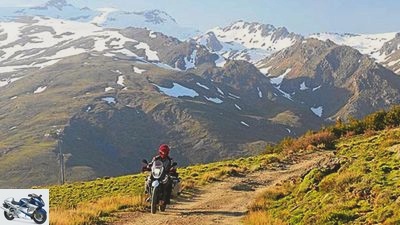
Deleker
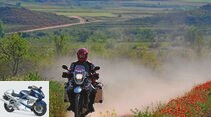
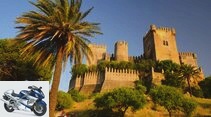
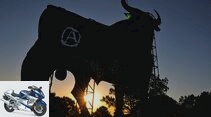
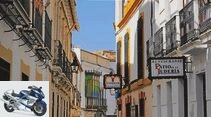
15th pictures
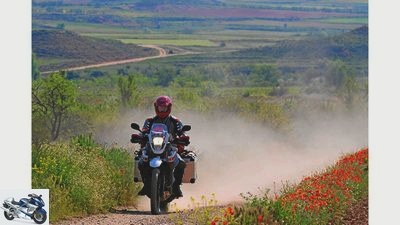
Deleker
1/15
With the motorcycle across Spain, a trip with many highlights.
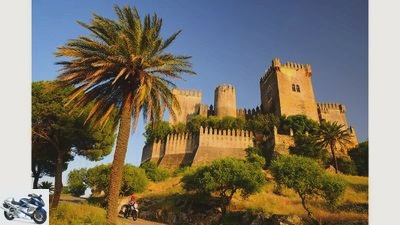
Deleker
2/15
Ready for a movie: Spain’s castles are travel highlights.
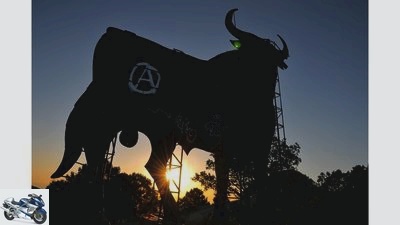
Deleker
3/15
Like in a picture book: Castello Almodóvar del Rio near Córdoba.
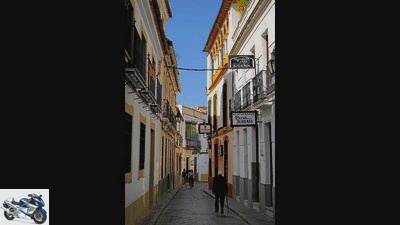
Deleker
4/15
Streetlife – Spain’s small towns are worth a visit, old town alley in Cordoba.
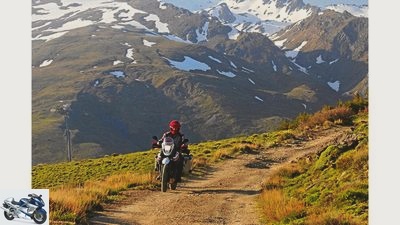
Deleker
5/15
Biker’s dream: driving in the Sierra Nevada.
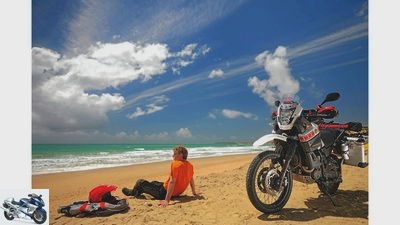
Deleker
6/15
Finally arrived: loneliness on the southern tip of Spain near Tarifa.
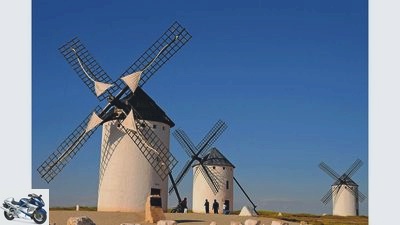
Deleker
7/15
Typical: The historic windmills are a symbol of the La Mancha region.
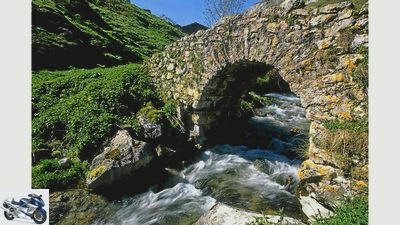
Deleker
8/15
Rustic: ancient stone bridge in the Picos de Europa near Sotres.
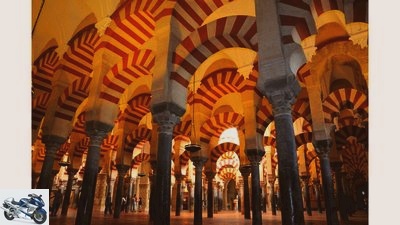
Deleker
9/15
Unique: 1200 year old mosque La Mezquita in Cordoba.
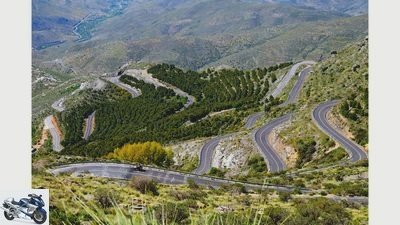
Deleker
10/15
Pass Alto de Velefique – sensation: zero traffic, finest tar.
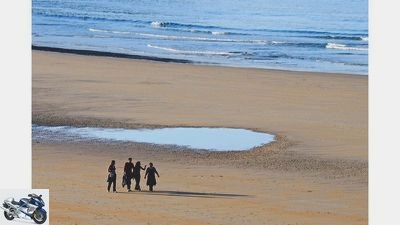
Deleker
11/15
Lonely: Atlantic beaches in the north on the Costa Verde.
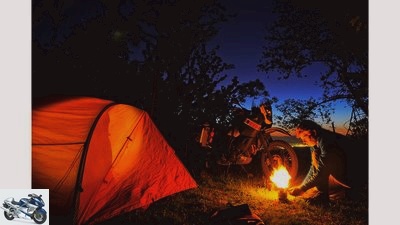
Deleker
12/15
The day goes by, Johnny Walker arrives: Camping in the Sierra Nevada.
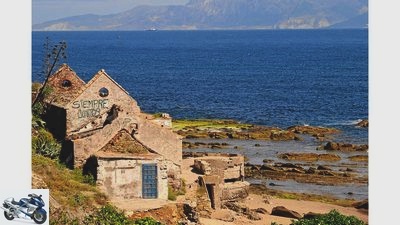
Deleker
13/15
Across the Strait of Gibraltar: the mountains of Morocco.
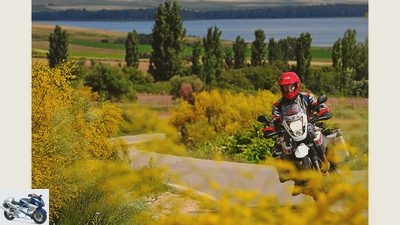
Deleker
14/15
Curved route in a dreamlike landscape.

Deleker
15/15
Curved roads in the coastal mountains of the Spanish Atlantic coast.
to travel
On the move: Spain from north to south
Motorcycle tour: Spain from north to south
By motorbike from Costa Verde to the Costa de la Luz
From coast to coast, from north to south, from the cool Costa Verde to the warm Costa de la Luz. A spring cruise along the Iberian Peninsula with surprising insights into the Spanish hinterland.
Joachim Deleker
03/29/2012
If you think of Spain’s coasts, the first thing that comes to mind is the summer-sun-beach-tourist industry with its monstrous building sins on the Mediterranean. But Spanish coasts can also be different. Completely different. My Tenere is parked by the Atlantic in the wide bay of San Vicente. Narrow-chested waves lap against the wide and pristine sandy beach in northern Cantabria. A few strollers trudge through the fine sand, sniff the cool sea breeze and look for mussels and flotsam. Mass tourism is elsewhere, loneliness and tranquility instead of entertainment and disco noise. Gentle green knolls roll inland, crash against a gigantic wall of sky-high rocks, the 2500 meter mountains Picos de Europa. That’s exactly where I want to go, I won’t see the sea again until the southern tip of Spain.
Less than 30 minutes later I am in the middle of these exciting mountains in the small village of Sotres. Here the path branches off over the Picos to Espinama. The narrow track bumps uphill on the lateral moraine of the Ice Age Morrena Glacier. The slope is more demanding than expected. Thick stones, washed-out gullies, greasy rock slabs, steep and awesome. The path follows the green ridge in a long arc, heading directly towards a snow-covered north face of alpine proportions. The altimeter shows 1700 meters when I reach the highest point. Take a break and enjoy. I got very warm, and so did the Tenere. Past a few fields of old snow, I rappel down into the narrow valley of Potes, where I treat myself to a few tapas and lively cortados, the Spanish espresso variant.
Buy complete article
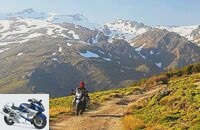
Motorcycle tour: Spain from north to south
By motorbike from Costa Verde to the Costa de la Luz
10 pages) as PDF
€ 2.00
Buy now
The map of the Picos shows a tangle of wonderful mountain roads, enough to curve around these magnificent rock massifs for a week. Tempting, but in the end I have the southern tip of Spain in my sights, and that is still a little way away. But there is still a little lap, up to the Puerto de San Glorio and the Mirador del Oso, the bear’s viewpoint. A life-size white stone bear looks up into the mountains. In addition, the top-class 360-degree panorama, unobstructed view of the spectacular Picos, the highest of which is at least 2648 meters.
South of the Picos I dive into the sparsely populated vastness of central Spain. A surprising expanse that I am only too happy to get involved in, which rewards a casually calm driving style with liberating relaxation. At some point I reach the Ebro – shortly after its source at the foot of the Sierra de Peña Labra, it is still a lively stream – and follow it southeast. A small sign greets me in the province of Aragon. The mountains stay behind, giving the Ebro a lot more space to widen and meander, and give me the chance to roll a few quick meters to the next famous river, the Rio Tajo, which flows across the country and near Lisbon as Rio Tejo flows into the Atlantic. Here, in the Serrania de Cuenca, the still young river has already done an impressive job, cutting a spectacular canyon out of the yellow-brown rock and modeling high vertical walls. The afternoon updrafts are used by griffon vultures, which seem to effortlessly make their laps over the gorge.
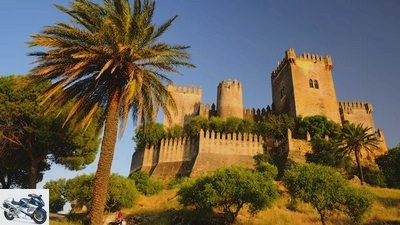
Deleker
Movie-ready: Spain’s castles are travel highlights.
The Yamaha has noticeably more trouble on the small, winding paths in the Serrania, but certainly also a lot more fun, as it doesn’t have to look for food, but rather for the ideal line. Which is not easy to find in the face of holes, patches and gravel. A demanding terrain, the contrast to the Central Iberian vastness that swallowed me up again to the west of Cuenca.
Many stress-free hours later I reach Consuegra in the province of La Mancha. On a hill, twelve white windmills, all of them finely restored, stretch their black wooden wings skyward, of course reminding of the stories of Don Quixote and his squire Sancho Panza. Old windmills are the landmark of the Mancha, hardly a hill on which not a mill is enthroned.
The timeless, quiet aura of the historic towers fits in perfectly with the clear landscape. The streets divide the green fields as endless straight bands. Poppies add red accents under the deep blue spring sky of Castile. Cool and crystal clear air everywhere. Man and machine go into the American highway mode, which is hardly possible in densely populated Central Europe, and cruise at a constant 90 things towards the horizon: hardly any places, hardly any traffic – pure deceleration. The lonely highlands gently undulate, barren chains of hills accompany me.
Until the landscape slowly wrinkles, mountains and valleys become more concise, the road has curves again, initially wide, then increasingly narrow. It goes down into the boring plain of the Rio Guadalquivir, which I reach below the mighty Castillo Almodóvar. Only a few more kilometers to Córdoba, a little sparkling city, blessed with one of the most impressive buildings in Europe: the La Mezquita mosque. 856 marble columns, all connected by arches, support the roof of the 1200 year old Mezquita in perfect harmony. Early in the morning, before the crowds babble through the architectural marvel, there is a heavenly, quiet atmosphere in the semi-darkness of the mosque. A place to be amazed, to relax, meditate, to enjoy. The atmosphere is even more intense than in the Alhambra.
The opposite of relaxation, i.e. maximum concentration, is required when I leave Córdoba for rush hour. I could be at the southern tip of Spain in barely four hours. Which would be outrageous, because Andalusia lies ahead of me, and the southern cape will still be stationary in four days’ time. Andalusia in spring is a dream that begins at the latest where the monotony of the olive groves ends. So 150 kilometers further, at the foot of the Sierra Nevada. The mountains loom up in deep snow and distant, their highest peak, the Mulhacen, at an altitude of 3482 meters. Around the Sierra, the road builders have carved passes with maximum addictive potential into the mountain flanks, loosened up with picture-perfect views over small villages and white peaks.
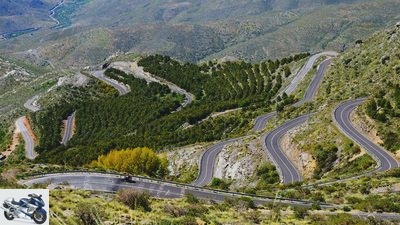
Deleker
Pass Alto de Velefique – sensation: zero traffic, finest tar.
Parallel to the Mediterranean coast, various mountains not only form massive bars to the inland, but above all the stuff that motorcyclists’ dreams are made of. You could be out and about for weeks, enjoying the mixture of the Mediterranean way of life, great scenery and the finest roads. Steep, densely forested mountains stretching to the horizon, some of which are extremely picturesque white villages, the famous Pueblos Blancos. Sierra Nevada, Sierras de Tejeda, Serrania de Ronda, Sierra Bermeja, mountains that hardly anyone outside of Spain knows, but which those who have crossed them on two motorized wheels can never forget.
But at some point I got dizzy enough and finally set my sights on the southern tip of Spain – Tarifa. The proximity to Africa becomes tangible. Be it the snow-white Moorish buildings, the flying African traders or the adventurously overloaded cars waiting in the harbor for the ferry to Morocco. Only 14 kilometers away, on the other side of the Strait of Gibraltar, I can see Africa clearly and even see individual houses. Africa, so close and yet so far.
A violent wanderlust attack attacks me. The exciting and incurable virus – here and now, almost 3,000 kilometers from home, strikes again. Memories boil up, of the ferry crossing to Morocco, of the fear of customs. 27 years ago we ventured to Africa for the first time, wanted to cross the Sahara in an old VW Bulli and finally stayed on the black continent for eight months. Speaking of wanderlust: shouldn’t I even show my Tenere its namesake in distant Niger? Yes, sure, sometime soon. If you no longer dream, your life is already behind you.
Info
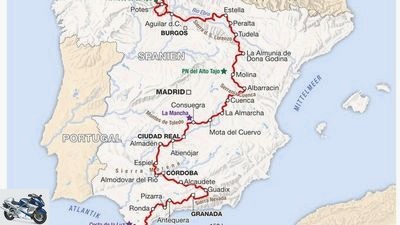
Werel
Travel time: 15 days. Distance covered: 3000 kilometers.
Spain in spring challenges and rewards all the senses. On the long way between the green north coast and the lonely beaches of the Costa de la Luz, the Iberian Peninsula surprises with a vastness and diversity that has become rare in Europe.
Getting there:
Spain is big, the journey is a long one. If you arrive on your own and want to go to Andalusia, you should have enough time in your luggage. The risk of stress is not insignificant for less than three weeks. From Cologne to Tarifa there is an easy 2500 kilometers. It is less stressful and more convenient to cover part of the route with the DB Autozug, which runs weekly from various German train stations to Narbonne in southern France. For example, a one-way trip from Dusseldorf costs from 266 euros per person and motorcycle, depending on the season. Information is available from DBAutozug, phone 0 18 05/24 12 24 or at www.dbautozug.de.
Travel time:
In the Picos de Europa, the Sierra Nevada and the many 2000-meter mountains inland, spring sometimes doesn’t come until mid-May. There can be a lot of snow here in winter. Andalusia, on the other hand, is a year-round destination. From June inland, especially in the hottest region on the Rio Guadalquivir, temperatures of up to 40 degrees can be expected. It will only become more bearable from the middle of September. However, the country is then parched by the sun, and the fresh spring green of May is long history. The best months to travel to central Spain are May, June and mid-September to the end of October. July and August are only suitable for guaranteed heat-resistant travelers.
Accommodation:
Especially away from the few tourist centers, it is not easy to find accommodation in the off-season. The few guesthouses and especially the campsites sometimes don’t open until mid-May and close in October. The situation is better in the larger towns and along the coast. In the lonely interior of the country there are often beautiful places to camp freely. Only in the high season in August it can get a bit crowded along the coast, in Andalusia and in the Picos de Europa, but never as overcrowded as along the Spanish Mediterranean coast.
Literature:
The best travel guides for Spain come from Michael Muller Verlag (24.90 euros) and Lonely Planet (26.99 euros). There are also a large number of regional travel guides, recommended are those from Reise Know-How Verlag Andalusia, Northern Spain and Catalonia and Michael Muller Verlag Andalusia and Northern Spain. The Michelin sheet 734 on a scale of 1: 1,000,000 is suitable as an overview map. The Michelin regional papers for all areas in Spain (573, 574, 575, 576, 578), scale 1: 400,000 each, price 7.50 euros are much more detailed.
Related articles
-
Motorcycle tour Peru – from south to north
Markus Biebricher 15th pictures Markus Biebricher 1/15 In Peru, one of the most diverse countries on earth, you can commute between the extremes. More…
-
On the way: from north to south through Africa
Obert 22nd pictures Obert 1/22 Sudan: invitation to dinner with new friends in the Nubian desert. Obert 2/22 Local motorcycle ferry across the Rovuma…
-
Motorcycle trip to the Sierra Nevada (Spain)
Daams Klaus H. 12th pictures Daams Klaus H. 1/12 In the highest mountains of the Iberian Peninsula, the sky is quite close, and the built-up Costa del…
-
On the move: Madrid and its sierras
Daams to travel On the move: Madrid and its sierras MOTORCYCLE On the go Madrid and its sierras They are not exactly around the corner, but are worth the…
-
to travel South America ?? Antarctic South America ?? Antarctic 42 degrees of latitude On two enduros through the Andes ?? from the Chilean Atacama…
-
to travel South America South America Patagonia Express Patagonia. Vastness. Huge glaciers. Bizarre mountains. And dusty slopes on which hardly anyone is…
-
Motorcycle tour – the north of Chile
Markus Biebricher 14th pictures Markus Biebricher 1/14 Communicative: break at the trucker bar in the middle of nowhere Markus Biebricher 2/14 Evening…
-
Johann to travel North Cape North Cape The other way Just don’t listen when they tell you again that the long journey to the North Cape is not worth it….
-
to travel South Portugal South Portugal Rock festival In the Algarve, the Atlantic has modeled a magnificent rocky landscape. Between the coast and the…
-
Out and about with a motorcycle in the south of France
shepherd 13th pictures shepherd 1/13 On the road with motorcycles in the south of France. There’s a lot to discover. shepherd 2/13 Asphalt surfing under…